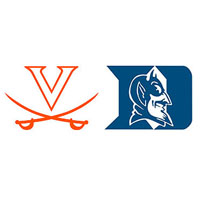
Unstoppable force, meet immovable object.
Fourth-ranked Duke (18-2, 6-2 ACC) has recovered from two early ACC stumbles on the road to win five straight, though four of those wins involved home-and-homes with Pitt and Wake Forest, who are a combined 1-14 in conference play.
#2 Virginia (19-1, 8-0 ACC) has won 11 straight overall, feasting to a degree itself on bottom-feeders in the ACC, with a pair of nice wins, over #10 North Carolina and #18 Clemson, thrown into the mix.
The game is a clash of so many differing styles and approaches that it can be hard to sort them all out. The offense vs. defense is the easy one, but there’s also tempo (Virginia ranks dead last nationally; Duke is 38th, and averages 12.2 more possessions per game than the ‘Hoos) and age (Duke is the second-youngest team in D1; Virginia’s eight-man rotation includes two redshirt seniors, a third senior starter and a redshirt junior).
Duke’s strength is obviously in its post play. Likely ACC player of the year and rookie of the Marvin Bagley III (21.6 ppg, 11.5 rebs/g, 60.7% FG) can do just about everything, scoring in the post, leading fast breaks at 6’11”, really only missing a consistent jumper, which will come sometime after his name is called first in the NBA draft in June.
If not for Bagley, 6’10” power forward Wendell Carter (14.4 ppg, 9.2 rebs/g, 61.5% FG) would be the talk of this year’s Duke one-and-done class. Carter is the better defensive player of the two – ranked 16th in the ACC in defensive rating, the only Blue Devil in the top 20, largely on the strength of his 2.0 blocked shots per game, which ranks seventh in the ACC.
The graybeard of the Duke rotation is 6’5” senior guard Grayson Allen (15.2 ppg, 43.8% FG, 38.6% 3FG), who has demonstrated the capacity for rising to the occasion when necessary.
Allen is joined in the backcourt by another pair of freshmen – 6’6” shooting guard Gary Trent Jr. (14.7 ppg, 43.2% FG, 43.1% 3FG) and 6’3” point guard Trevon Duval (11.5 ppg, 6.0 assists/g, 45.9% FG).
The rotation wasn’t much more than that starting five until the 96-85 loss at NC State on Jan. 6, when coach Mike Krzyzewski used Javin DeLaurier for 15 minutes, Antonio Vrankovic for four, and that was it until garbage time.
Coach K has gone to his bench a little more lately. 6’6” freshman guard Alex McConnell has averaged 12.3 minutes per game over the last five, averaging 5.6 points per game, and DeLaurier has gotten double-digit minutes in each of Duke’s last two games.
Even so, three Blue Devils average 32+ minutes per game, and Carter is the only starter averaging less than 29.3 minutes, mainly because of foul issues (Carter has fouled out two times, and had four fouls in a game seven others).
Keys to the Game: Virginia
Pack integrity: Teams that have the most success against Virginia’s Pack-Line defense are those that attack with dribble-drives. The Pack-Line generally has success against teams that feed the post due to the post-to-post doubles that coach Tony Bennett uses to try to force the ball back out of the lane. Duke has the three-point shooters to convert openings on the perimeter (hitting 37.3 percent of threes in ACC play, third in the conference), but even a couple of early makes won’t translate over 40 minutes. The focus needs to be on getting the ball back out of the post.
Attack the midrange: Duke will start out in man and then go to 2-3 zone when the man doesn’t work anymore, and that’s inevitable. Virginia’s mover-blocker should draw Bagley and Carter out from under the basket and might entice the foul-prone Carter into early foul trouble. Isaiah Wilkins and De’Andre Hunter will need to hit a couple of midrange jumpers early to open up the lane for dribble-drives and curl cuts for the guards. That success will push Coach K into going zone, at which point Virginia goes zone offense, with Wilkins, Hunter and Ty Jerome setting up in the high post, the weak spot in a 2-3. The key will be attacking that spot, around the foul line, with short jumpers, dribble-drives and kick-outs to the perimeter, and Hunter, in particular, with his athleticism, finishing at the rim.
Chairmen of the boards: Duke leads the nation in offensive rebounding percentage (39.3 percent), with Carter averaging 3.0 per game, and Bagley averaging 4.0 per game. You can’t post-to-post double out of a stickback situation, so keeping those guys off the offensive glass will be incumbent. Virginia had an atrocious stretch in the wins over UNC (which rebounded 48.7 percent of its misses), Syracuse (51.4 percent) and NC State (40 percent), but has, er, rebounded of late (Georgia Tech 26.9 percent, Wake Forest 20 percent, Clemson 18.8 percent). But, yeah, none of those teams has elite offensive rebounders like Bagley and Carter.
Preview by Chris Graham










